Properties of Soil-Based Flowable Fill under Drying–Wetting and Freeze–Thaw Actions
Abstract
1. Introduction
2. Materials and Methods
2.1. Materials
2.2. Specimen Preparation
2.3. Drying–Wetting and Freeze–Thaw Actions
- The specimens were submerged in clean water at 20 °C for 5 h;
- The specimens were then moved to an oven at 65 °C for 18 h to dry, then transferred to room temperature to complete a drying–wetting cycle;
- Steps 1 and 2 were repeated for the specimens that required more than one drying–wetting cycle.
- The specimens were placed in a −15 °C refrigerator for 12 h to freeze them;
- The specimens were then moved to a curing box at 20 °C temperature and >95% relative humidity for 12 h to thaw;
- Steps 1 and 2 were repeated for the specimens that required more than one freeze–thaw cycle.
2.4. Testing Methods
2.5. Testing Programme
3. Results
3.1. Performances after Drying–Wetting Cycles
3.2. Performances after Freeze–Thaw Cycles
4. Discussion
4.1. Mechanisms of Drying–Wetting and Freeze–Thaw Actions
4.2. Prediction of Strength Reduction and Degradation
4.3. Practical Implications
- Flowable fills can utilize waste soils generated from the same construction site or from nearby projects. This greatly reduces the cost of both waste soil disposal and conventional earth or rockfill transportation. The related gasoline consumption can be avoided. The land spaces and potential contaminants related to disposal of waste soils can also be saved.
- The strength of flowable fills can be adjusted for various applications. For highway embankments, the flowable fills with relatively high strength can improve the stability of embankment slopes. Therefore, the embankment slopes can be designed at a higher angle to save land spaces. This feature is especially important for highway widening projects and construction in urban areas with limited land resources.
- Conventional earth or rockfills for constructions are not environmentally friendly. The exploitation of earth or rock resources is harmful to natural environments. Earth or rockfills need mechanical compactions to meet quality requirements, which is also time-consuming and requires high energy consumption. The use of flowable fills in lieu of these conventional fill materials can mitigate these problems.
- The use of Portland cement in flowable fills leads to extra costs, and there are carbon emissions related to the production of Portland cement. However, some industrial wastes with large outputs can be used to replace Portland cement in flowable fills. The waste materials with cementing effects involve fly ash, bottom ash, cement kiln dust, etc. [13,14,15,16]. Flowable fills are an alternative solution to the reuse of these industrial wastes.
- Radical drying–wetting cycles in flowable fills should be prevented. Measures that can be adopted involve using water-resistant front plates, water resistance sheets, or drainage systems. The addition of low-permeable ingredients in the flowable fill, such as bentonite and diatomaceous, may also reduce the effects of drying–wetting on the flowable fills [6].
- In cold regions with seasonally frozen grounds, strength reduction due to the freeze–thaw cycles may be considered, especially for heavy load-bearing structures such as highway embankments.
- Experimental results presented in this study may be used as references if the degradation of flowable fills in drying–wetting or freeze–thaw actions need to be considered. The empirical model for strength reduction given above can also be utilized for long-term strength prediction under the drying–wetting cycles.
5. Conclusions
- Under six drying–wetting cycles, flowable fill specimens underwent continuous reductions in strength, accompanying the mass losses and the changes in micro-structures. The level of strength reduction decreased with increased addition of Portland cement and decreased addition of water. After six drying–wetting cycles, the specimens showed a 27–51% strength reduction as compared to their counterparts with no drying–wetting actions.
- Under freeze–thaw cycles, the specimens showed noticeable but insignificant degradation. After six freeze–thaw cycles, the level of strength reduction ranged from 9 -20%. For most the test groups, the strength reduction completed or almost completed within the first three cycles, and showed minimal changes in strength afterwards.
- The flowable fill specimens under continuous drying–wetting cycles showed gradual and more gentle changes in the strength reduction with further cycles. Based on this variation pattern, an empirical model was proposed to predict the strength reduction under drying–wetting cycles. The prediction results are in agreement with the test data for most of the test groups.
- The use of flowable fills can bring about not only technological advantages, but also environmental benefits. However, precautions should be taken during radical drying–wetting cycle conditions in order to prevent the degradation of the material.
Author Contributions
Funding
Institutional Review Board Statement
Informed Consent Statement
Data Availability Statement
Conflicts of Interest
References
- Ling, T.-C.; Kaliyavaradhan, S.K.; Poon, C.S. Global perspective on application of controlled low-strength material (CLSM) for trench backfilling–An overview. Constr. Build. Mater. 2018, 15, 535–548. [Google Scholar] [CrossRef]
- Sargand, S. The Design and Construction of culverts using Controlled Low Strength Material–Controlled Density Fill (CLSM–CDF) Backfill. In Structural Performance of Flexible Pipes, Proceedings of the First National Conference on Flexible Pipes, Columbus, OH, USA, 21–23 October 1990; Brewer, W., Ed.; CRC Press: Boca Raton, FL, USA, 1990. [Google Scholar]
- Riviera, P.P.; Bertagnoli, G.; Choorackal, E.; Santagata, E. Controlled low-strength materials for pavement foundations in highway tunnels: Feasibility study and recommendations. Mater. Struct. 2019, 52, 1–16. [Google Scholar] [CrossRef]
- Qian, J.; Hu, Y.; Zhang, J.; Xiao, W.; Ling, J. Evaluation the performance of controlled low strength material made of excess excavated soil. J. Clean. Prod. 2019, 214, 79–88. [Google Scholar] [CrossRef]
- Okuyucu, O.; Jayawickrama, P.; Senadheera, S. Mechanical properties of steel fiber–reinforced self-consolidating controlled low-strength material for pavement base layers. J. Mater. Civ. Eng. 2019, 31, 04019177. [Google Scholar] [CrossRef]
- ACI Committee 229. ACI 229R-13. Report on Controlled Low-Strength Materials; American Concrete Institute: Farmington Hills, MI, USA, 2013. [Google Scholar]
- Kim, Y.-S.; Do, T.M.; Kim, H.-K.; Kang, G. Utilization of excavated soil in coal ash-based controlled low strength material (CLSM). Constr. Build. Mater. 2016, 124, 598–605. [Google Scholar] [CrossRef]
- Finney, A.J.; Shorey, E.F.; Anderson, J. Use of native soil in place of aggregate in controlled low strength material (CLSM). In Pipelines 2008—Pipeline Asset Management: Maximizing Performance of our Pipeline Infrastructure; American Society of Civil Engineers: Reston, VA, USA, 2008; pp. 1–13. [Google Scholar]
- Wu, H.; Yin, J.; Bai, S. Experimental Investigation of Utilizing Industrial Waste and Byproduct Materials in Controlled Low Strength Materials (CLSM). Adv. Mat. Res. 2013, 639–640, 299–303. [Google Scholar] [CrossRef]
- Zhang, J.; Wang, J.; Li, X.; Zhou, T.; Guo, Y. Rapid-hardening controlled low strength materials made of recycled fine aggregate from construction and demolition waste. Constr. Build. Mater. 2018, 173, 81–89. [Google Scholar] [CrossRef]
- Zhang, X.; Yu, R.; Chen, J. Preparation and properties of controlled compacting filling material based on admixture technique. Emerg. Mater. Res. 2018, 7, 47–51. [Google Scholar] [CrossRef]
- Guangyin, Z.; Haiyan, Z.; Tiantao, Z.; Youcai, Z. Performance appraisal of controlled low-strength material using sewage sludge and refuse incineration bottom ash. Chin. J. Chem. Eng. 2012, 20, 80–88. [Google Scholar]
- Naganathan, S.; Razak, H.A.; Hamid, S.N.A. Properties of controlled low-strength material made using industrial waste incineration bottom ash and quarry dust. Mater. Des. 2012, 33, 56–63. [Google Scholar] [CrossRef]
- Le, D.-H.; Nguyen, K.-H. An assessment of eco-friendly controlled low-strength material. Procedia Eng. 2016, 142, 260–267. [Google Scholar] [CrossRef]
- Lachemi, M.; Hossain, K.; Shehata, M.; Thaha, W. Controlled low strength materials incorporating cement kiln dust from various sources. Cem. Concr. Compos. 2008, 30, 381–392. [Google Scholar] [CrossRef]
- Siddique, R. Utilization of waste materials and by-products in producing controlled low-strength materials. Resour. Conserv. Recycl. 2010, 54, 1–8. [Google Scholar] [CrossRef]
- Wu, H.; Huang, B.; Shu, X.; Yin, J. Utilization of solid wastes/byproducts from paper mills in Controlled Low Strength Material (CLSM). Constr. Build. Mater. 2016, 118, 155–163. [Google Scholar] [CrossRef]
- Bassani, M.; Bertola, M.; Bianchi, M.; Canonico, F.; Marian, M. Environmental assessment and geomechanical properties of controlled low-strength materials with recycled and alternative components for cements and aggregates. Cem. Concr. Compos. 2017, 80, 143–156. [Google Scholar] [CrossRef]
- Yan, D.Y.S.; Tang, I.Y.; Lo, I.M.C. Development of controlled low-strength material derived from beneficial reuse of bottom ash and sediment for green construction. Constr. Build. Mater. 2014, 64, 201–207. [Google Scholar] [CrossRef]
- Kuo, W.T.; Wang, H.Y.; Shu, C.Y.; Su, D.S. Engineering properties of controlled low-strength materials containing waste oyster shells. Constr. Build. Mater. 2013, 46, 128–133. [Google Scholar] [CrossRef]
- Bouzalakos, S.; Dudeney, A.W.L.; Cheeseman, C.R. Controlled low-strength materials containing waste precipitates from mineral processing. Miner. Eng. 2008, 21, 252–263. [Google Scholar] [CrossRef]
- Mneina, A.; Soliman, A.M.; Ahmed, A.; El Naggar, M.H. Engineering properties of Controlled Low-Strength Materials containing Treated Oil Sand Waste. Constr. Build. Mater. 2018, 159, 277–285. [Google Scholar] [CrossRef]
- Etxeberria, M.; Ainchil, J.; Pérez, M.E.; González, A. Use of recycled fine aggregates for Control Low Strength Materials (CLSMs) production. Constr. Build. Mater. 2013, 44, 142–148. [Google Scholar] [CrossRef]
- Angulo, S.C.; Ulsen, C.; John, V.M.; Kahn, H.; Cincotto, M.A. Chemical–mineralogical characterization of C&D waste recycled aggregates from São Paulo, Brazil. Waste Manag. 2009, 29, 721–730. [Google Scholar] [PubMed]
- Türkel, S. Strength properties of fly ash based controlled low strength materials. J. Hazard. Mater. 2007, 147, 1015–1019. [Google Scholar] [CrossRef] [PubMed]
- Nataraja, M.; Nalanda, Y. Performance of industrial by-products in controlled low-strength materials (CLSM). Waste Manag. 2008, 28, 1168–1181. [Google Scholar] [CrossRef] [PubMed]
- Alizadeh, V. Influence of cementing paste volume on properties of controlled low strength materials. J. Mater. Civ. Eng. 2018, 30, 04017305. [Google Scholar] [CrossRef]
- Neramitkornburi, A.; Horpibulsuk, S.; Shen, S.L.; Chinkulkijniwat, A.; Arulrajah, A.; Disfani, M.M. Durability against wetting–drying cycles of sustainable Lightweight Cellular Cemented construction material comprising clay and fly ash wastes. Constr. Build. Mater. 2015, 77, 41–49. [Google Scholar] [CrossRef]
- Ye, H.; Chu, C.; Xu, L.; Guo, K.; Li, D. Experimental studies on drying-wetting cycle characteristics of expansive soils improved by industrial wastes. Adv. Civ. Eng. 2018, 2018, 2321361. [Google Scholar] [CrossRef]
- Stoltz, G.; Cuisinier, O.; Masrouri, F. Weathering of a lime-treated clayey soil by drying and wetting cycles. Eng. Geol. 2014, 181, 281–289. [Google Scholar] [CrossRef]
- Jian-Hua, W.; Yu-Qin, G. Study on the Strength Degradation Mechanism of Cement-Soils Resulting from Dry-Wet Cycles. Chi. Railw. Sci. 2006, 27, 23–27. [Google Scholar]
- Lachemi, M.; Hossain, K.M.; Shehata, M.; Thaha, W. Characteristics of controlled low-strength materials incorporating cement kiln dust. Can. J. Civil Eng. 2007, 34, 485–495. [Google Scholar] [CrossRef]
- Achtemichuk, S.; Hubbard, J.; Sluce, R.; Shehata, M.H. The utilization of recycled concrete aggregate to produce controlled low-strength materials without using Portland cement. Cem. Concr. Compos. 2009, 31, 564–569. [Google Scholar] [CrossRef]
- Pan, T. Mechanical Properties and Crack Development Characteristics of Cement-Solidified Mud Soil under Dry-Wet-Freeze-Thaw Cycles. J. Chin. Ceram. Soc. 2021, 40, 34–40. [Google Scholar]
- Shibi, T.; Kamei, T. Effect of freeze–thaw cycles on the strength and physical properties of cement-stabilised soil containing recycled bassanite and coal ash. Cold Reg. Sci. Technol. 2014, 106, 36–45. [Google Scholar] [CrossRef]
- Ding, M.; Zhang, F.; Ling, X.; Lin, B. Effects of freeze-thaw cycles on mechanical properties of polypropylene Fiber and cement stabilized clay. Cold Reg. Sci. Technol. 2018, 154, 155–165. [Google Scholar] [CrossRef]
- Tianliang, W.; Jiankum, L.; Liyun, P.; Yahu, T. Research on the Mechanical Properties of the Cement-Modified Soil under the Action of Freezing and Thawing Cycle. Chi. Railw. Sci. 2010, 31, 7–13. [Google Scholar]
- Jamshidi, R.J.; Lake, C.B.; Gunning, P.; Hills, C.D. The effect of freeze/thaw cycles on the performance and microstructure of cement-treated soils. J. Mater. Civ. Eng. 2016, 28, 04016162. [Google Scholar] [CrossRef]
- Liu, J.; Wang, T.; Tian, Y. Experimental study of the dynamic properties of cement-and lime-modified clay soils subjected to freeze–thaw cycles. Cold Reg. Sci. Technol. 2010, 61, 29–33. [Google Scholar] [CrossRef]
- Qian, J.; Shu, X.; Dong, Q.; Ling, J.; Huang, B. Laboratory characterization of controlled low-strength materials. Mater. Des. 2015, 65, 806–813. [Google Scholar] [CrossRef]
- Bao-Kuan, N.; Si-Li, C.; Bin, L. Influence of freezing and thawing cycles on mechanical properties of cemented soil. Low Temp. Phys. 2004, 2004, 10–12. [Google Scholar]
- Lake, C.B.; Yousif, M.A.-M.; Jamshidi, R.J. Examining freeze/thaw effects on performance and morphology of a lightly cemented soil. Cold Reg. Sci. Technol. 2017, 134, 33–44. [Google Scholar] [CrossRef]
- Sili, C.; Jianjun, S.; Tao, Y.; Jie, H. Effect of Freezing-thawing Cycle on the Mechanical Behaviors of Cemented Soil. J. Pet. Sci. Eng. 2014, 22, 343–349. [Google Scholar]
- Aldaood, A.; Bouasker, M.; Al-Mukhtar, M. Impact of freeze–thaw cycles on mechanical behaviour of lime stabilized gypseous soils. Cold Reg. Sci. Technol. 2014, 99, 38–45. [Google Scholar] [CrossRef]
- Wentai, P.; Xiangdong, S. Effect of freeze-thaw cycles on the mechanical properties of hydromulch. Highway 2012, 9, 20–32. [Google Scholar]
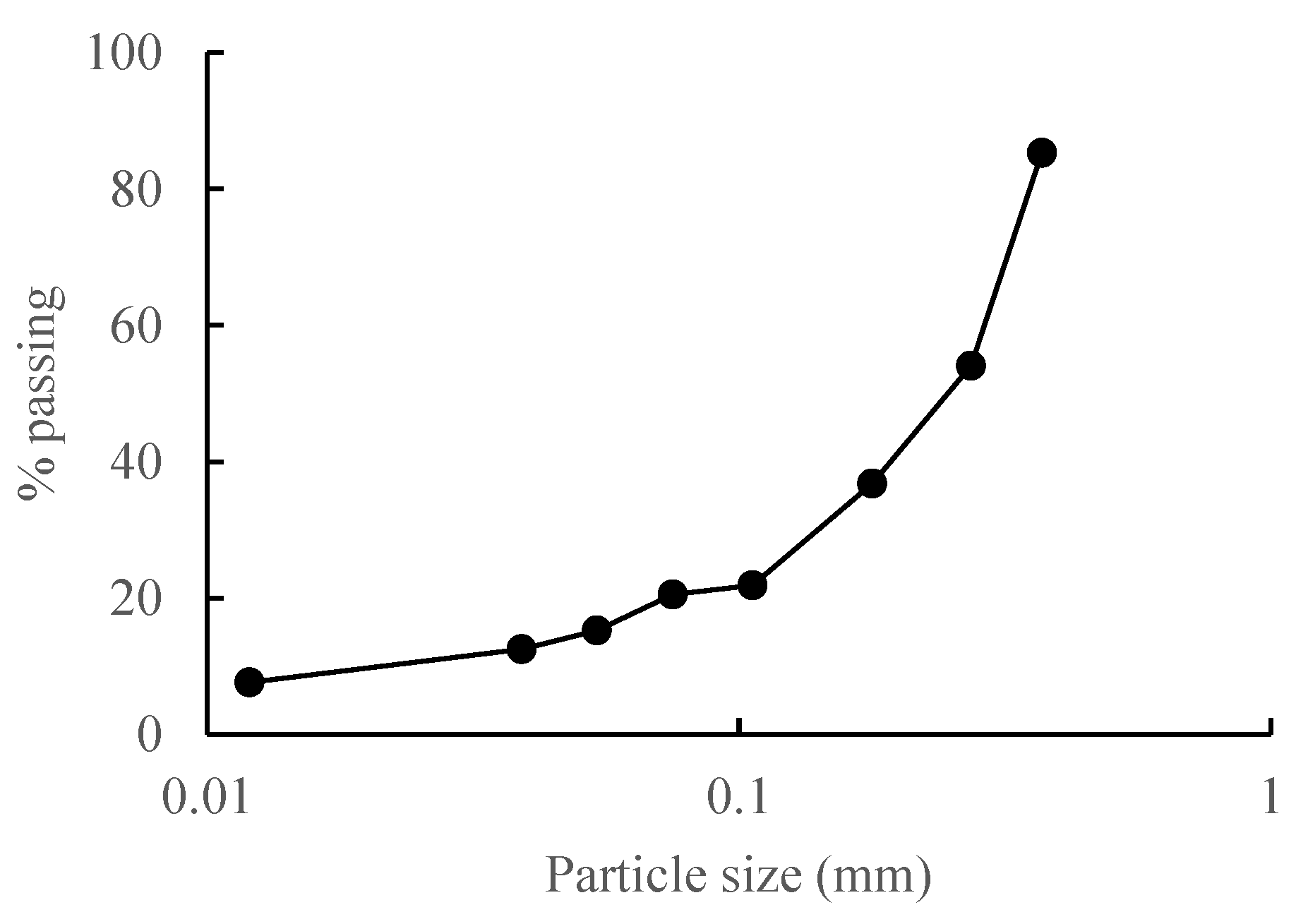
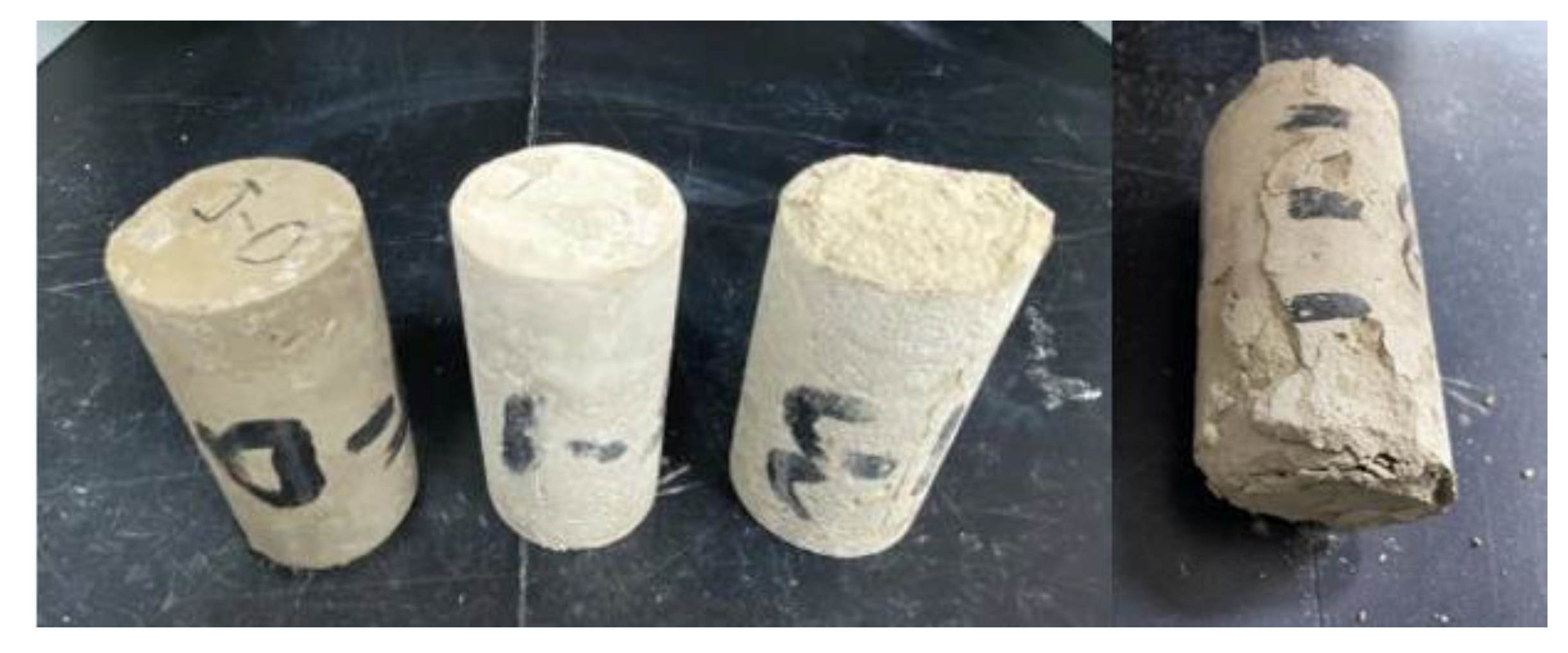
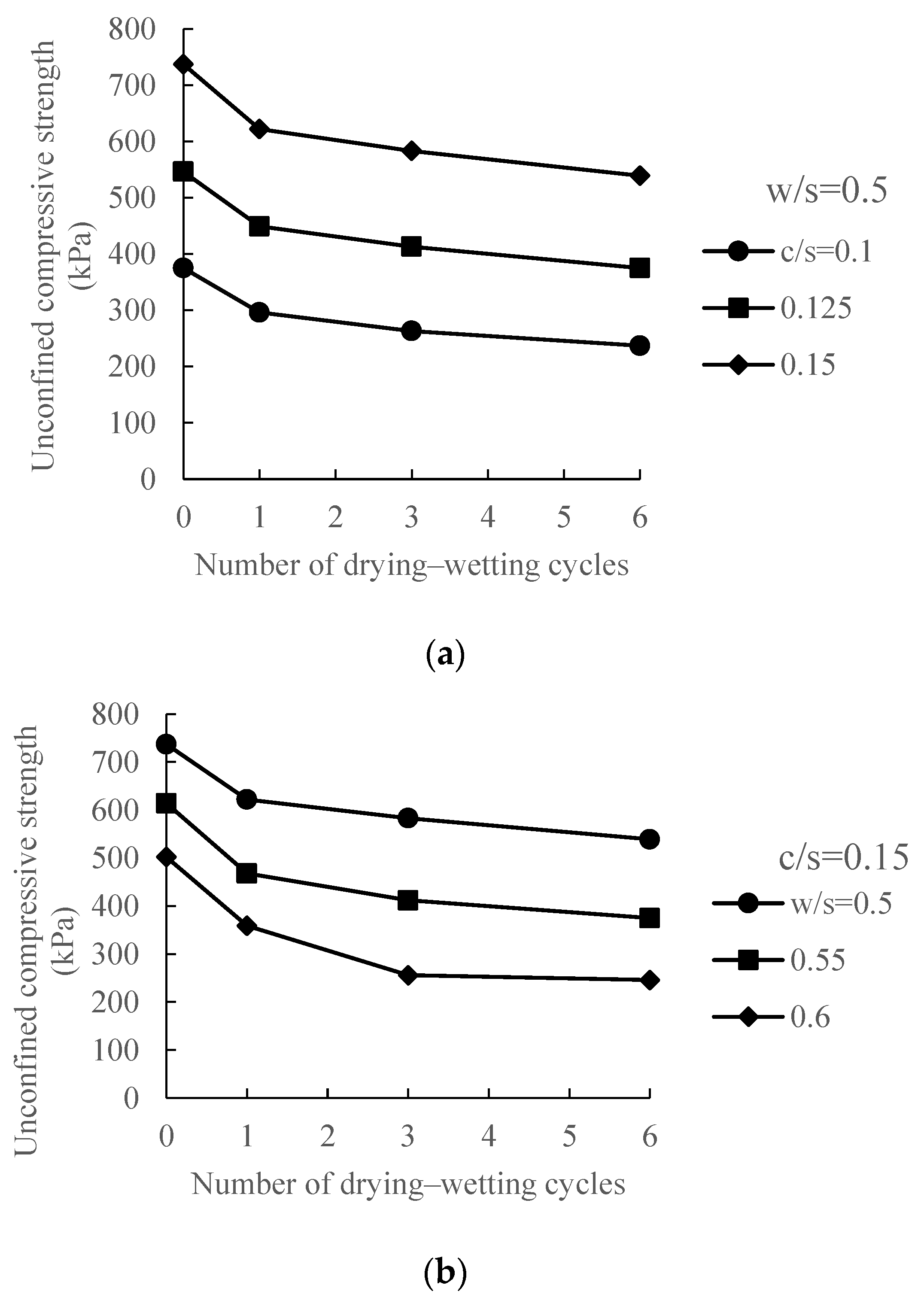
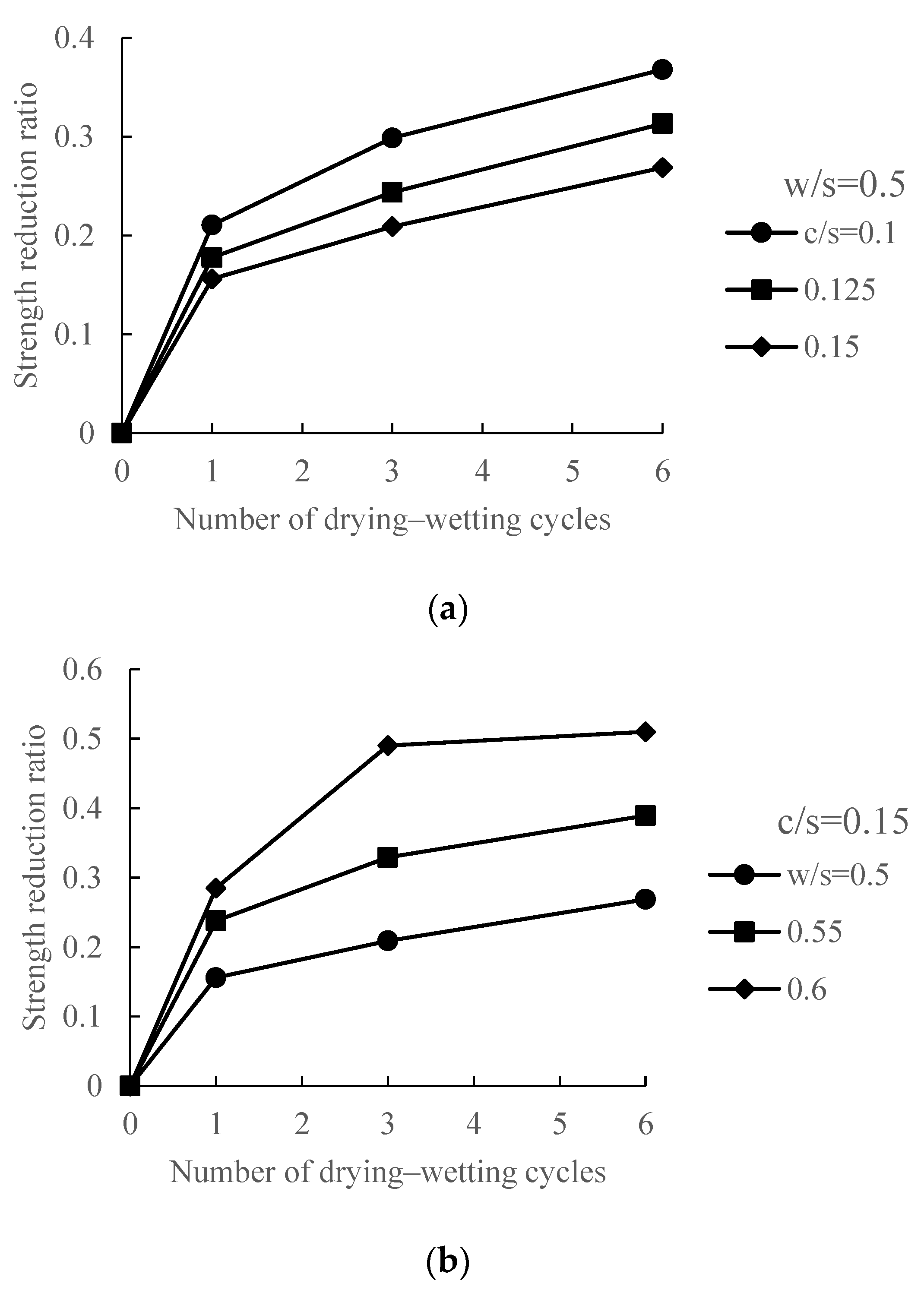

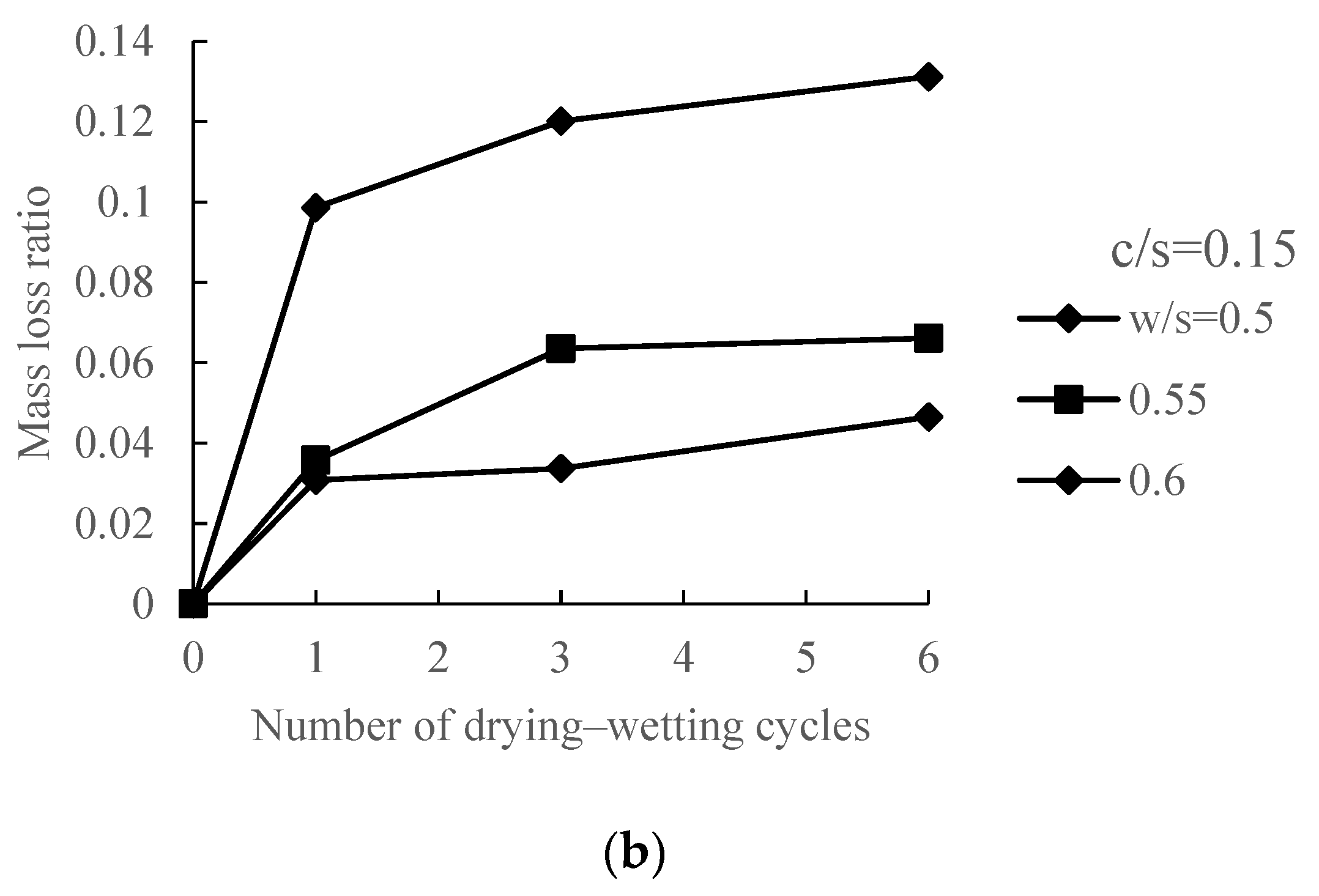
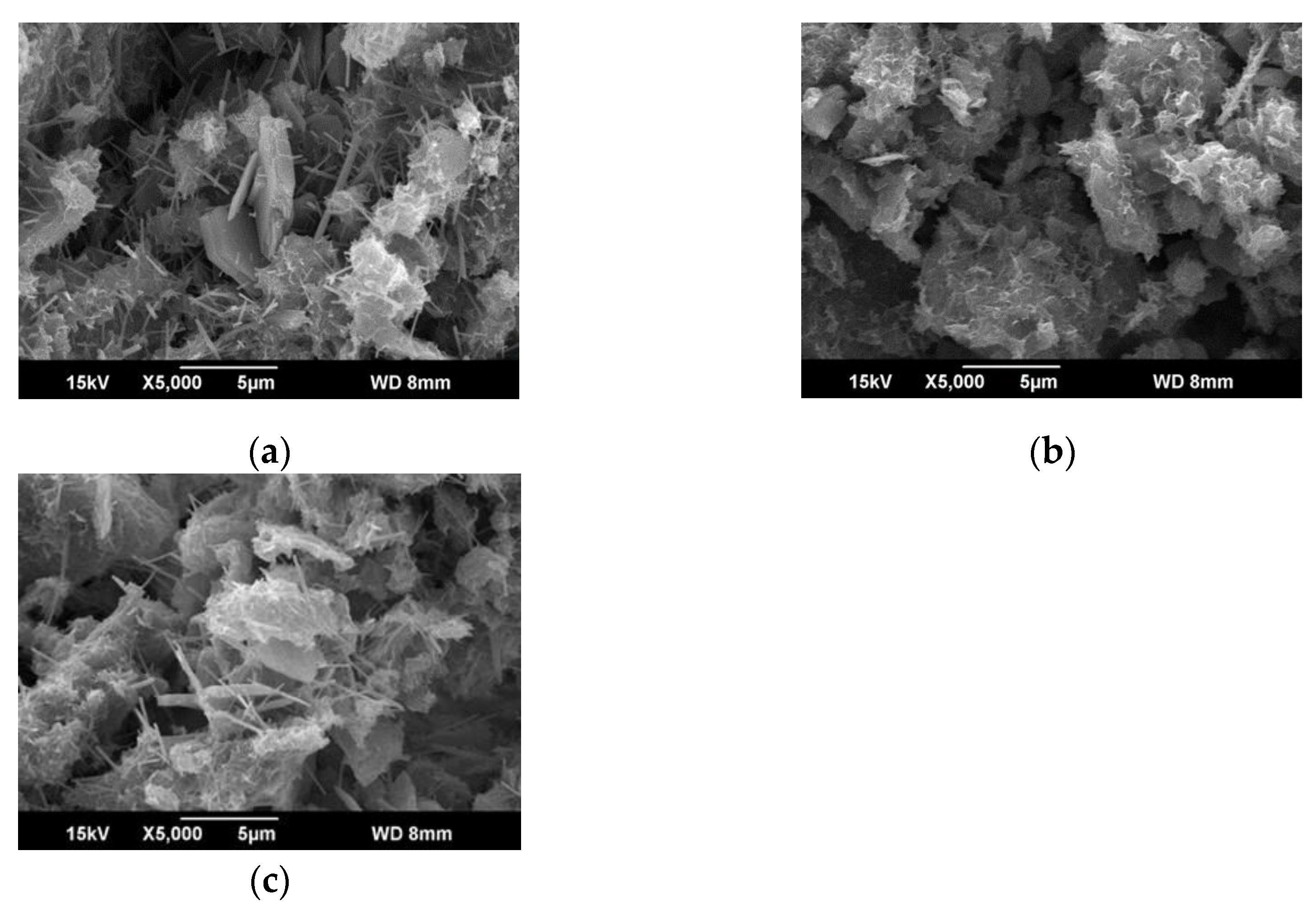

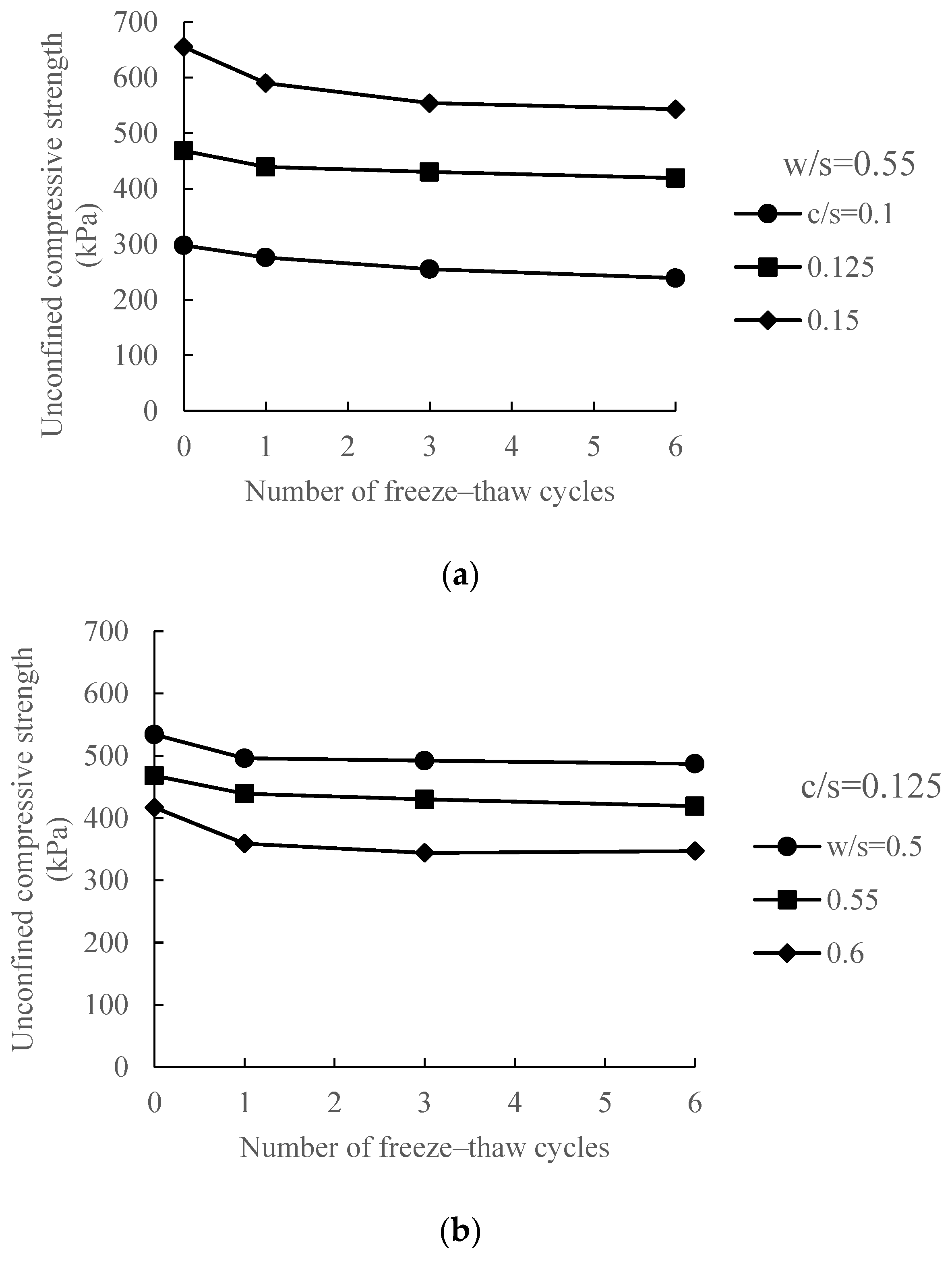
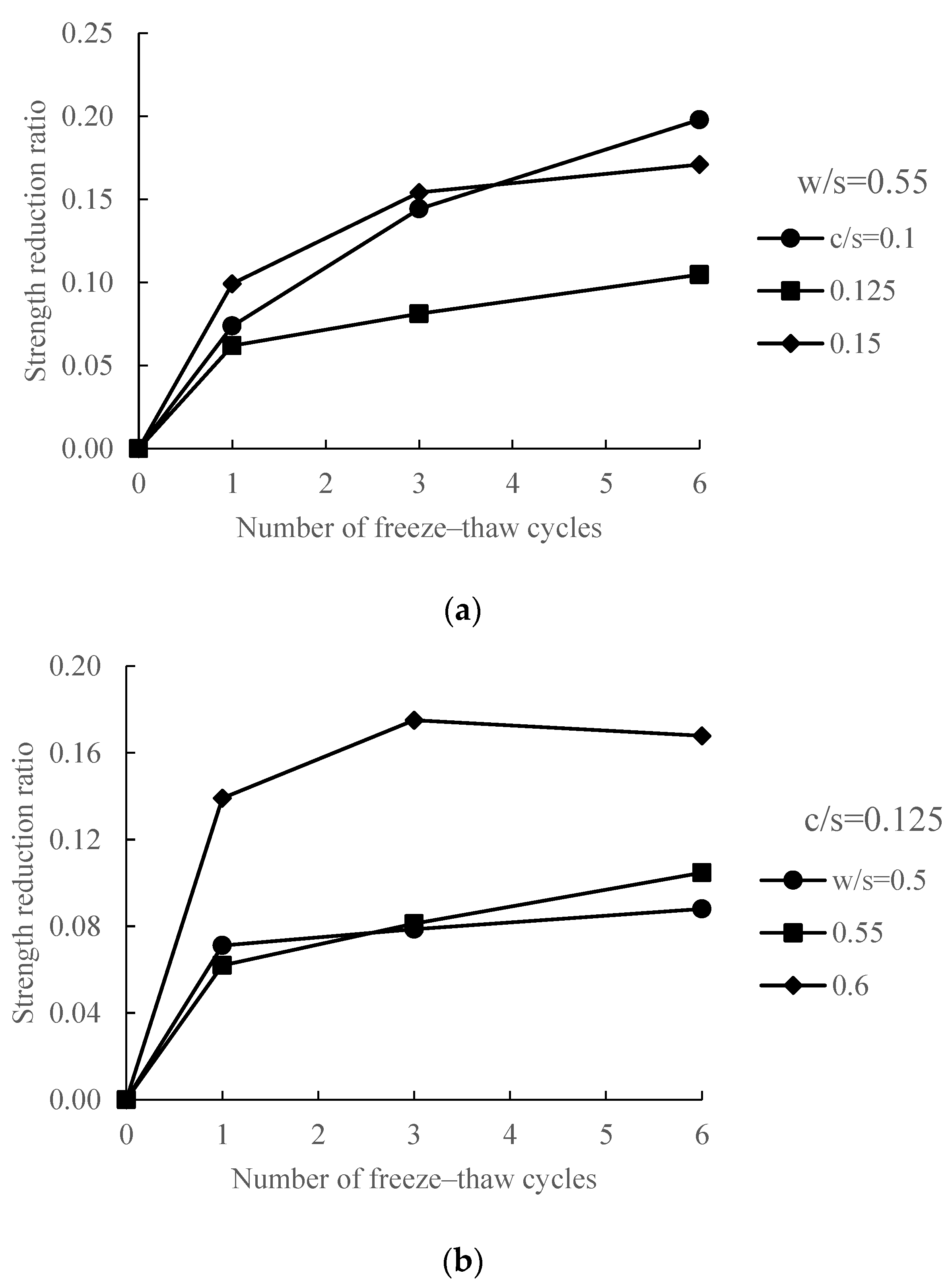
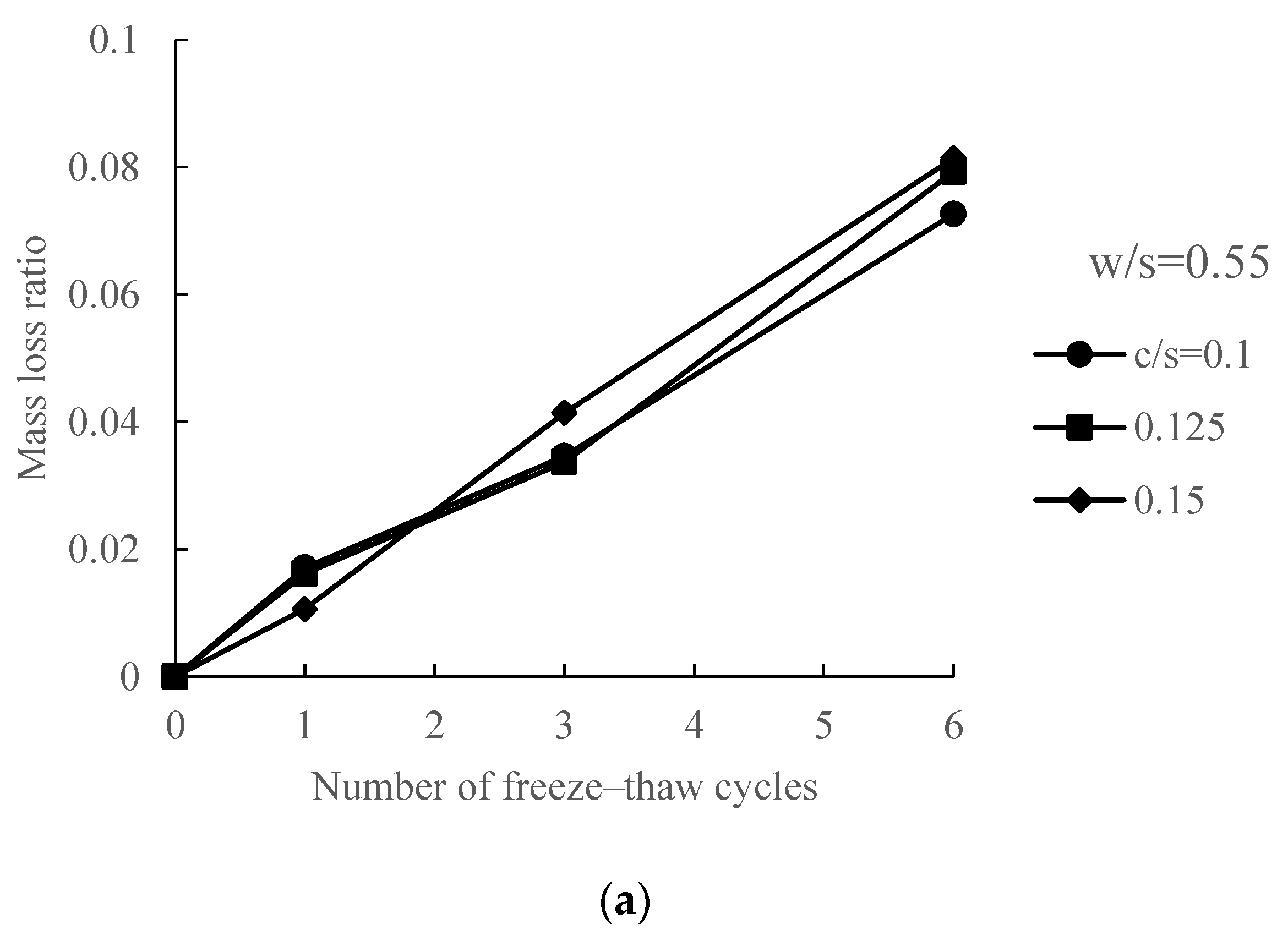


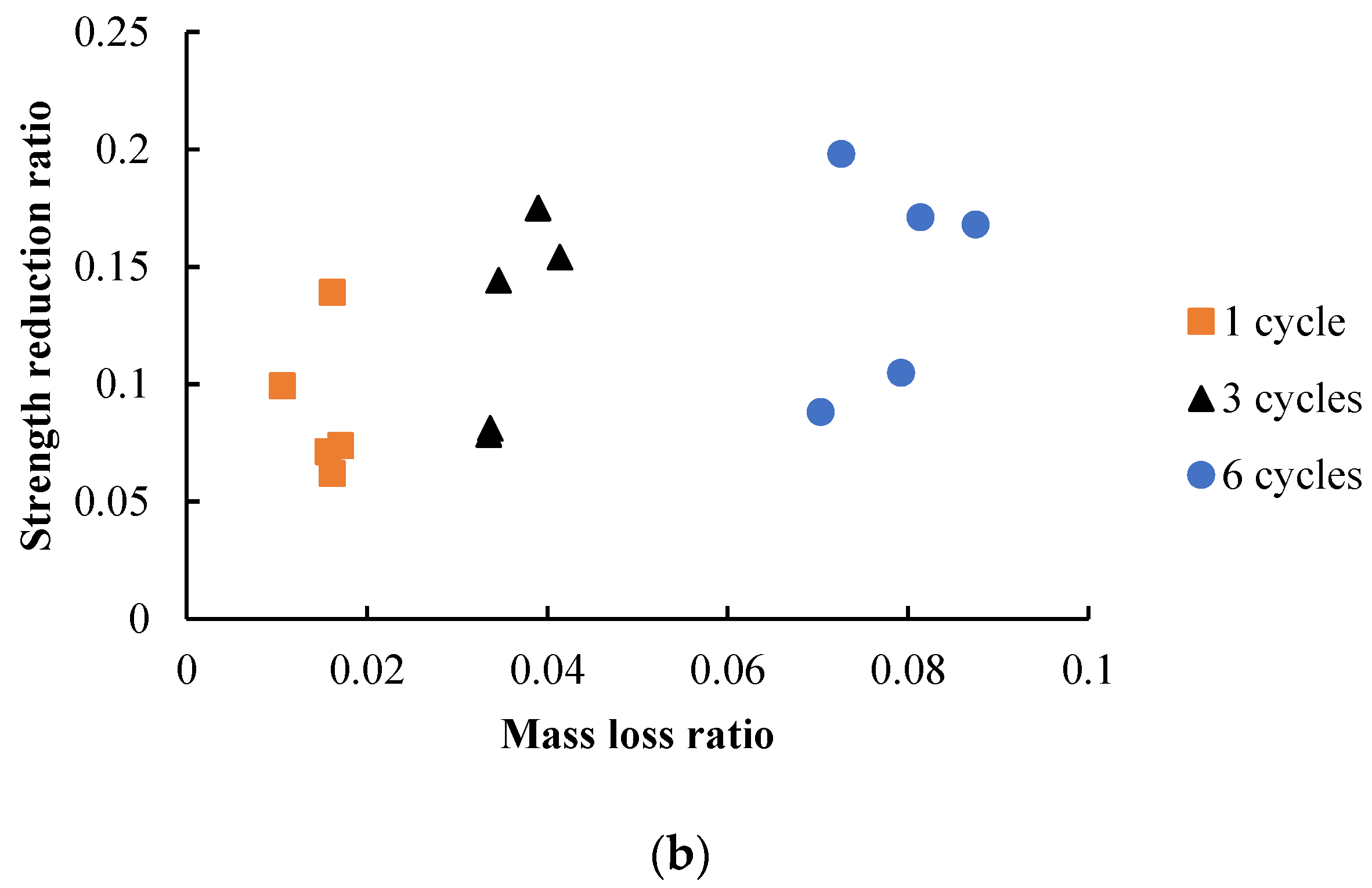
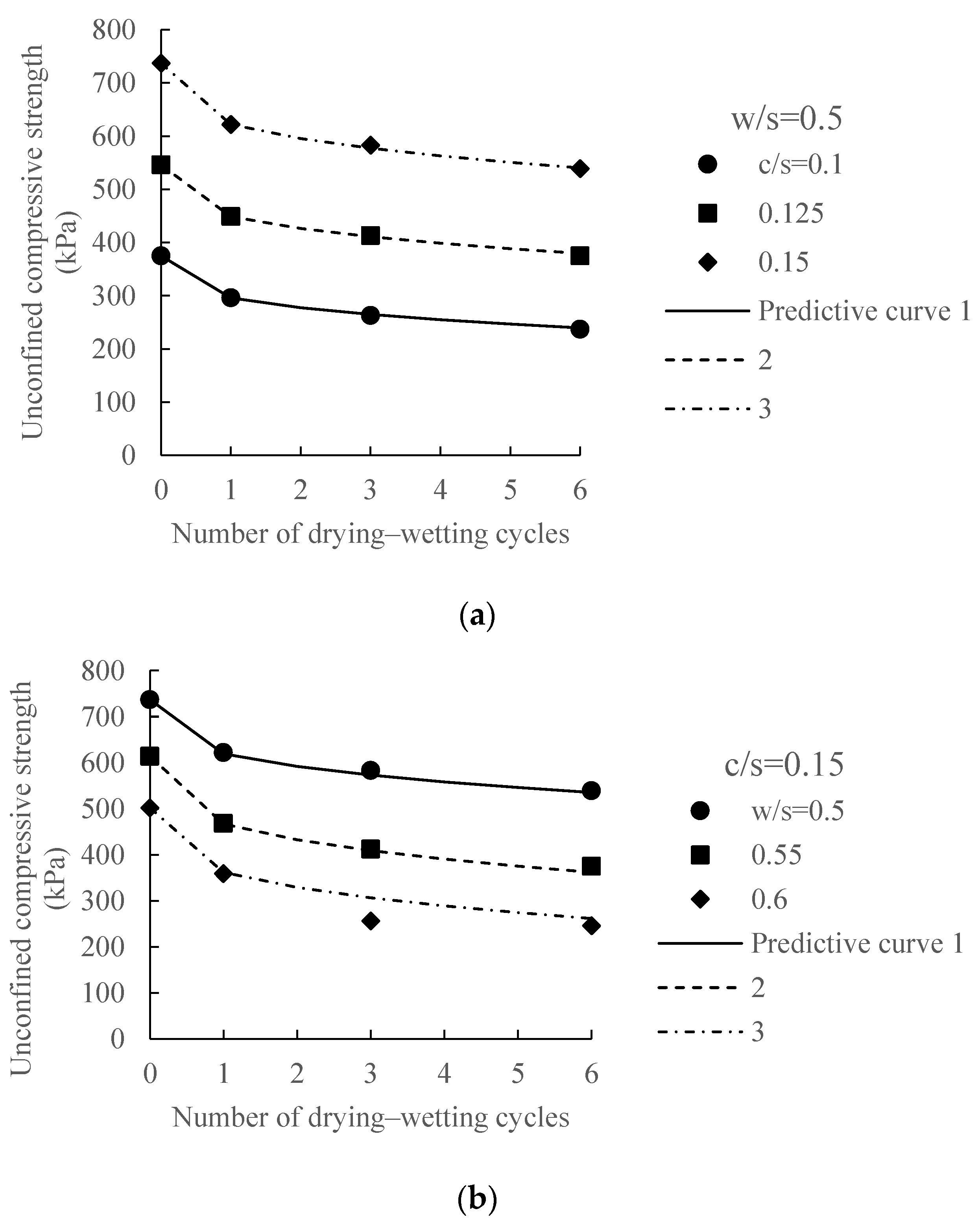
| Test No. | Water/Soil (w/s) Ratio | Cement/Soil (c/s) Ratio | Number of Drying–Wetting Cycles |
|---|---|---|---|
| 1 | 0.5 | 0.1 | 0, 1, 3, 6 |
| 2 | 0.5 | 0.125 | 0, 1, 3, 6 |
| 3 | 0.5 | 0.15 | 0, 1, 3, 6 |
| 4 | 0.55 | 0.15 | 0, 1, 3, 6 |
| 5 | 0.6 | 0.15 | 0, 1, 3, 6 |
| Test No. | Water/Soil (w/s) Ratio | Cement/Soil (c/s) Ratio | Number of Freeze–Thaw Cycles |
|---|---|---|---|
| 6 | 0.55 | 0.1 | 0, 1, 3, 6 |
| 7 | 0.55 | 0.125 | 0, 1, 3, 6 |
| 8 | 0.55 | 0.15 | 0, 1, 3, 6 |
| 9 | 0.5 | 0.125 | 0, 1, 3, 6 |
| 10 | 0.6 | 0.125 | 0, 1, 3, 6 |
Disclaimer/Publisher’s Note: The statements, opinions and data contained in all publications are solely those of the individual author(s) and contributor(s) and not of MDPI and/or the editor(s). MDPI and/or the editor(s) disclaim responsibility for any injury to people or property resulting from any ideas, methods, instructions or products referred to in the content. |
© 2023 by the authors. Licensee MDPI, Basel, Switzerland. This article is an open access article distributed under the terms and conditions of the Creative Commons Attribution (CC BY) license (https://creativecommons.org/licenses/by/4.0/).
Share and Cite
Huang, Z.; Tong, T.; Liu, H.; Qi, W. Properties of Soil-Based Flowable Fill under Drying–Wetting and Freeze–Thaw Actions. Sustainability 2023, 15, 2390. https://doi.org/10.3390/su15032390
Huang Z, Tong T, Liu H, Qi W. Properties of Soil-Based Flowable Fill under Drying–Wetting and Freeze–Thaw Actions. Sustainability. 2023; 15(3):2390. https://doi.org/10.3390/su15032390
Chicago/Turabian StyleHuang, Zheng, Teng Tong, Hao Liu, and Wen Qi. 2023. "Properties of Soil-Based Flowable Fill under Drying–Wetting and Freeze–Thaw Actions" Sustainability 15, no. 3: 2390. https://doi.org/10.3390/su15032390
APA StyleHuang, Z., Tong, T., Liu, H., & Qi, W. (2023). Properties of Soil-Based Flowable Fill under Drying–Wetting and Freeze–Thaw Actions. Sustainability, 15(3), 2390. https://doi.org/10.3390/su15032390





